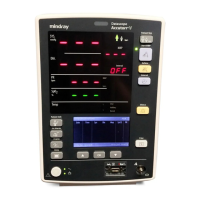Manual NIBP Measurements Operation
3 - 12 0070-10-0699-02 Accutorr V Operating Instructions
The skin is sometimes fragile (i.e., on pediatrics, geriatrics, etc.). In these cases, consider a
longer timer interval to decrease the number of cuff inflations over a period of time.
NOTE: In extreme cases, a thin layer of soft roll or webril cotton
padding may be applied to the limb in order to cushion the
skin when the cuff is inflated. This measure may affect NIBP
performance and should be used with caution.
2. Attach the cuff hose to the NIBP connector (34) by holding the hose behind the knurled
pressure fitting (female). Push onto the male connector until a “click” is heard. To
remove, hold the knurled female fitting and pull firmly to release.
3. Apply the cuff to the patient. To reduce errors, the cuff should fit snugly, but with enough
room for two fingers to be placed between the cuff and the patient’s arm (on adults), and
with little or no air present within the cuff. The cuff should fit loosely on neonates. Apply
the cuff so that the center of the inflation bag (bladder) is over the brachial artery. Be
sure that the INDEX line on the cuff falls between the two RANGE lines. If not, a larger or
smaller cuff is required. Be sure the cuff lies directly against the patient’s skin. For best
results, the cuff should be placed on the arm at heart level, and no clothing should come
between the patient and the cuff.
NOTE: Avoid compression or restriction of the pressure hose. Do
not place the NIBP cuff on a limb that is being utilized for
any other medical procedure. For example, an I.V. Catheter.
4. If required, select the Patient Size with (23). On initial power up, the configurable
default setting is used. Otherwise, the last selected patient size is used. Initial default cuff
inflation pressure depends on the Patient Size setting. See section 3.5.3 for details on
changing the initial cuff inflation pressure.
5. Press (24) to begin an NIBP measurement. During inflation and deflation of the
cuff, the Accutorr V displays the bladder pressure in the MAP display.
NOTE: Inflate the cuff only after proper application to the patient’s
limb. Cuff damage can result if the cuff is left unwrapped
and then inflated.
The cuff begins to inflate to the selected cuff pressure. After reaching the selected pressure,
the cuff begins to slowly deflate, and the Accutorr V collects oscillometric pulsations.
If the unit detects inadequate initial cuff inflation, the unit retries with a higher inflation
pressure (+50 mmHg in the adult and pediatric modes; +40 mmHg in the neonate mode).
Have the patient remain still to avoid unnecessary motion artifact. After the cuff pressure
drops below the diastolic pressure, the results of the measurement are displayed, and the cuff
deflates.
NOTE: When required, press (25) to interrupt a
measurement and deflate the cuff.
NOTE: Once the initial measurement is taken, the Accutorr V
continues to use the selected patient size.
NOTE: Check the patient’s limb for any indications of circulation
impairment.

